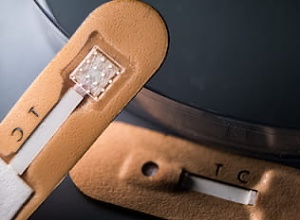Testing for malaria and other infectious diseases could become as simple as putting on a microneedle patch that does not require extracting blood, using a Rice University-developed device.
The device draws upon protein biomarkers contained in dermal interstitial fluid, what people generally recognise as the fluid inside blisters but surrounds all of the cells in skin.
This fluid contains a multitude of biomarkers for various diseases, such as malaria, which can be used for rapid testing. The disposable patches could be programmed to detect other diseases, potentially including COVID-19, said mechanical engineer Peter Lillehoj of the Rice University Brown School of Engineering.
"In this paper, we focus on malaria detection because this project was funded by the Bill and Melinda Gates Foundation, and it's a big priority for them," said Lillehoj, who joined Rice in January as an associate professor of mechanical engineering. "But we can adapt this technology to detect other diseases for which biomarkers appear in interstitial fluid."
The self-contained test developed by Lillehoj and lead author Xue Jiang, a Rice post-doctoral researcher, delivers a result in about 20 minutes and does not require medical expertise or any equipment.
The sticky patch has 16 hollow microneedles in a 4-by-4 array on one side, coupled with an antibody-based lateral-flow test strip on the other. The antibodies react when they sense protein biomarkers for malaria and turn two readout lines on the strip's exposed surface red. If the test is negative, only one line turns red.
The needles are treated to be hydrophilic – that is, attracted to water – so the fluid is drawn in and flows through to the test strip. Once the test is complete, the device can be removed like any bandage.
While both microneedles and antibody test strips have been extensively studied, Lillehoj said his lab is the first to combine them into a simple, inexpensive package that will be easy to deploy at the point of need, especially in developing regions where finger-prick blood sampling and the availability of trained medical personnel to diagnose samples may be challenging.
The hollow needles are 375 microns wide and 750 microns long, enough to reach the fluid within skin that is typically between 800 to 1,000 microns thick. The needles are sharp enough to overcome the mechanical stress of entering the skin.
"Xue and I have applied the patch to our skin, and it doesn't feel painful at all compared to a finger prick or a blood draw," Lillehoj said. "It's less painful than getting a splinter. I would say it feels like putting tape on your skin and then peeling it off."
They think the familiar form factor may provide some comfort, especially to children. "We didn't intend for it to look like a bandage," he said. "We started with a rectangular shape and then just rounded the edges to make it a little more presentable. We didn't plan for that, but perhaps it makes the patch more relatable to the general public."
He estimated individual patches could cost about $1 if and when they are produced in bulk.
Abstract
Rapid diagnostic tests are one of the most commonly used tests to detect and screen for infectious diseases in the developing world. While these tests are simple, inexpensive, and readily available, they rely on finger-prick blood sampling, which requires trained medical personnel, poses risks of infection, and can complicate cooperation in young children, asymptomatic individuals, and communities with blood taboos. Here, we report a novel microneedle-based skin patch for the rapid detection of protein biomarkers in dermal interstitial fluid. Sample collection is facilitated by a hydrophilic hollow microneedle array that autonomously extracts and transports interstitial fluid to an antibody-based lateral flow test strip via surface tension for colorimetric antigen detection. We employ a simple gold enhancement treatment to enhance the detection sensitivity of this colloidal gold-based lateral flow assay and elucidate the underlying mechanism of this enhancement mechanism through experimental investigation. For proof-of-concept, this device was used to detect Plasmodium falciparum histidine-rich protein 2, a biomarker for malaria infection, which could be detected at concentrations as low as 8 ng/mL. Each test can be completed in <20 min and requires no equipment. To the best of our knowledge, this work is the first demonstration of a microneedle-based lateral flow assay for rapid protein detection in dermal interstitial fluid. In addition to its simplicity, minimally invasive nature, and low cost, this diagnostic device can be readily adapted to detect other protein biomarkers in interstitial fluid, making it a promising tool for point-of-care testing.
Authors
Xue Jiang, Peter B Lillehoj
[link url="https://news.rice.edu/2020/11/02/malaria-test-as-simple-as-a-bandage-2/"]Rice University material[/link]
[link url="https://www.nature.com/articles/s41378-020-00206-1"]Microsystems & Nanoengineering full text (open access)[/link]

